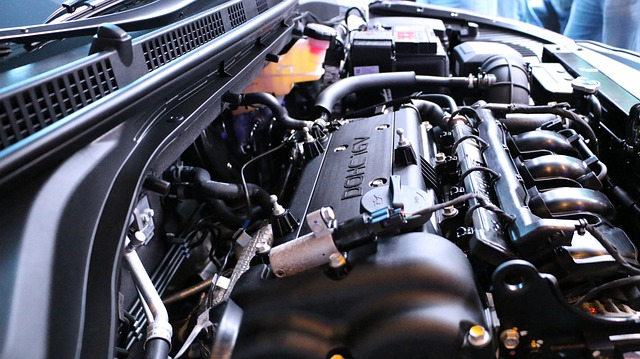Looking to register your car in California? This comprehensive guide breaks down the process step-by-step. From understanding key requirements to obtaining a license plate, learn everything you need to know for a smooth DMV visit. We cover essential documents, critical dvm vin verification, and efficient application methods. Ensure your vehicle complies with California regulations and hit the road legally!
- Understand California Car Registration Requirements
- Gather Necessary Documents for DMV Visit
- Perform Vehicle Identification Number (VIN) Verification
- Complete Application and Pay Fees at DMV
- Obtain License Plate and Register Your Vehicle
Understand California Car Registration Requirements

Before registering your car in California, it’s crucial to understand the state’s specific requirements. The California Department of Motor Vehicles (DMV) mandates that all vehicles operating within the state be properly registered and regularly inspected. One key component of this process is the DMV VIN verification, which ensures that the vehicle matches the reported details and isn’t a stolen or unauthorized copy. This verification involves checking the vehicle’s unique Vehicle Identification Number (VIN).
Additionally, for your convenience, many services offer mobile VIN inspection and verification options, allowing you to complete this step without visiting a DMV office. These services can be particularly useful if you’ve recently purchased a used car or are facing any issues with scheduling an in-person appointment. Understanding these requirements and utilizing available resources will ensure a smooth registration process for your California vehicle.
Gather Necessary Documents for DMV Visit

Before visiting the DMV, make sure you have all the essential documents and information at hand for a smooth registration process. You’ll need to bring along proof of identity, such as a valid driver’s license or state-issued ID card, and proof of residency, like a utility bill or bank statement. Additionally, the vehicle’s owner must provide a completed and signed Bill of Sale, which includes details like the seller’s and buyer’s names, the vehicle identification number (VIN), and purchase price.
A crucial step in preparing for your DMV visit is to undergo a DMV VIN verification process. This involves checking the vehicle’s history using its unique VIN. You can facilitate this with a mobile vin verifier or conduct a mobile vin inspection yourself before heading to the DMV, ensuring any potential issues are identified early on.
Perform Vehicle Identification Number (VIN) Verification

Before proceeding with the registration process, it’s crucial to perform a Vehicle Identification Number (VIN) verification. This step is essential for ensuring that your car is legitimate and free from any legal issues or outstanding recalls. The California DMV offers two options for this: you can either conduct the verification at a designated DMV office or use a mobile vin verifier.
A mobile vin inspection involves taking photos of the VIN plate, which is typically located on the vehicle’s dashboard or door frame, and then submitting them to a certified service. This convenient option allows you to complete the initial check from the comfort of your home or even while on the go. Once the verification is done, either through a mobile vin verifier or at a DMV office, you’ll have one less hurdle to navigate during the car registration process in California.
Complete Application and Pay Fees at DMV

To register your car in California, the first step is to complete the necessary application forms at the Department of Motor Vehicles (DMV). This involves gathering important documents like proof of ownership, vehicle identification number (VIN) verification, and valid identification. The DMV provides a comprehensive list of requirements on their website to ensure a smooth process.
Once all the required documents are in order, you’ll need to pay the associated fees. These include registration fees, title transfer charges, and possibly additional costs for specific services like mobile VIN inspection or a parallel import vehicle inspection, depending on your vehicle’s origin and condition. The DMV offers various payment methods, so be prepared with cash, card, or check to expedite the process.
Obtain License Plate and Register Your Vehicle

After completing your vehicle’s purchase, the next step in California is to obtain a license plate and register your car with the Department of Motor Vehicles (DMV). This process involves several crucial steps. First, schedule an appointment at your local DMV office or use their online services for a convenient experience. During your visit, you’ll need to bring essential documents like proof of ownership, vehicle identification number (VIN) inspection, and valid identification. The VIN is a unique code that serves as the key for identifying your vehicle; ensure it’s correctly verified through a mobile vin verifier or during the dmv vin verification process.
Once all required documentation is in order, you can apply for registration. This typically involves filling out an application form, paying the necessary fees, and submitting additional paperwork if there are any modifications to your car. After successful submission, you’ll be issued a license plate, which needs to be securely attached to your vehicle. Always ensure your vehicle is compliant with local regulations by maintaining current registration and proper VIN inspection throughout ownership.
Registering a car in California is a straightforward process that involves understanding the state’s requirements, gathering essential documents, and completing a few key steps. By performing a DMV VIN verification and ensuring all applications are filled out accurately, you can efficiently register your vehicle and hit the road legally. Remember to keep your registration up-to-date for smooth sailing on California’s highways.



